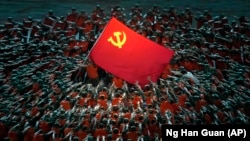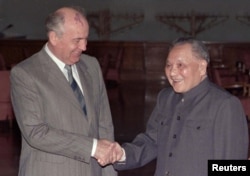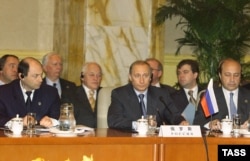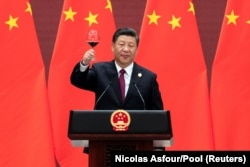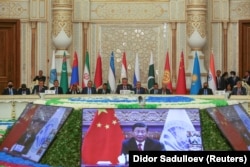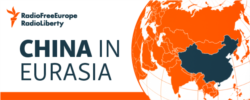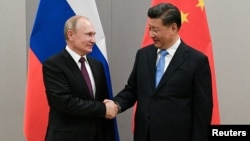
Welcome back to the China In Eurasia briefing, an RFE/RL newsletter tracking China’s resurgent influence from Eastern Europe to Central Asia.
I’m RFE/RL correspondent Reid Standish and here’s what I’m following right now.
The collapse of the Soviet Union is still seen as a cautionary tale in Beijing, but it paved the way for China’s three-decade rise as a power across Eurasia.
Not only did it mark a dramatic reversal of fortunes for Beijing and Moscow, the effects of this shift are still being felt today as the 30th anniversary of the collapse of the Soviet Union draws near, as I explained here.
Finding Perspective: The Soviet Union’s dissolution, which officially took place on December 26, 1991, and the creation of 15 new states was a source of fear and anxiety in Beijing.
But the end of tensions with Moscow, which had been simmering since a border conflict between the two countries in 1969, freed up Chinese resources and planning to focus outside its borders -- and away from a potential Soviet threat -- in a way that wasn’t previously possible.
This set China up to become a leading force in Eurasia and elsewhere. Not only was Beijing propelled on a path of steep economic growth that saw decades of improving living standards at home, it was also able to forge new political ties with its neighbors and eventually launch the globe-spanning Belt and Road Initiative (BRI).
Over the following decades, China slowly expanded its influence westward, with the region increasingly becoming a focus for its policymakers.
The Soviet Union’s end also deeply impacted thinking at the top in Beijing. Avoiding a similar fate has been a fixation for the Chinese Communist Party’s top brass, including Xi Jinping, who called the U.S.S.R.'s dissolution “a profound lesson” that many China watchers say has helped fuel Beijing’s tough crackdowns and desire for control over varying aspects of life -- from curbing the amount of time young people can play video games to recently limiting vasectomies for men.
Why It Matters: As Peter Frankopan, professor of global history at Oxford and author of the book Silk Roads, told me, one of the big takeaways for understanding China’s rise across Eurasia after the collapse of the Soviet Union is how unforeseen such a development was at the time.
“There was a widespread conviction that communism was dead; that socialist states would fail; and that China’s direction of travel was predictable, straightforward, and inevitably one of convergence with the Western world,” Frankopan said.
In this vein, the story of China’s rise across the former Soviet space is just one piece of the puzzle of Beijing’s new influence in Eurasia. Another crucial part is Western complacency and policy missteps.
“[There was] a profound lack of thought around what China’s rise meant, either in its own terms, in Eurasia, or even globally,” Frankopan told me. “We are paying the price for that today.”
Read More
● The Chinese Communist Party wants the world to see China’s continued rise as inevitable, but it is anything but, write Eric Zhu and Tom Orlik for Bloomberg.
● For a deeper look at what China learned from the collapse of the Soviet Union (and China’s impact on Moscow), read this excerpt from Chris Miller’s book The Struggle To Save The Soviet Economy.
● China’s admission to the WTO was a largely unnoticed event of epic geopolitical and economic importance. The BBC’s Faisal Islam takes a look at the decision’s legacy 20 years later.
Expert Corner: How Will The EU Handle Olympic Boycotts?
Readers asked: “The United States has announced a diplomatic boycott of the Olympics. Will the European Union follow suit?”
To find out more, I asked Finbarr Bermingham, the Europe correspondent for the South China Morning Post, who is based in Brussels:
“I think the EU is unlikely to follow the U.S.-led boycott. Like most issues related to China, it's proven impossible to get member states to discuss it, let alone come to a common position.
“I was surprised late last week when four separate member states and senior EU officials briefed that a boycott would be discussed at this week's Foreign Affairs Council. For months, Brussels had been brushing off my questions about it, saying sports was a ‘member state competency.’
“In the end, it wasn't discussed. ‘We ran out of time,’ one diplomat told me. ‘It was not on the agenda,’ said a prickly Josep Borrell, the EU’s foreign policy chief, when I asked him about it, even though that morning he'd told us to ask him about it later.
“Brussels says it hasn't decided whether to send commissioners, the French tell me ‘there's still time’ to debate, but I sense reluctance to follow Washington on this one.
“Lithuania and Belgium have already said they won't send officials and the Dutch are mulling it, but don't expect an EU-led blanket move."
Do you have a question about China’s growing footprint in Eurasia? Send it to me at StandishR@rferl.org or reply directly to this e-mail and I’ll get it answered by leading experts and policymakers.
Three More Stories From Eurasia
1. Can There Be Justice For Xinjiang?
An unofficial London-based tribunal investigating China’s oppression of the Uyghur people charged Xi Jinping and high-ranking members of his government with genocide, crimes against humanity, and systematic torture against Uyghurs, Kazakhs, and other Muslim minorities in Xinjiang, RFE/RL reported.
What’s Next?: The Uyghur Tribunal comprises lawyers, academics, and businesspeople, but it has no government backing or powers to sanction or punish Beijing.
Its organizers, however, hope the process of publicly laying out evidence will compel international action to tackle alleged abuses in China’s western province and can act as an important symbol.
The tribunal is part of a raft of recent measures attempting to hold China accountable for alleged atrocities in Xinjiang, which the Chinese government denies.
The U.S. House of Representatives voted 428-to-1 to ban imports from Xinjiang over concerns about forced labor, and the United Nations' human rights office is finalizing its report on alleged abuses against Uyghurs and other groups.
Tajikistan is also the subject of a recent filing by Uyghur groups to the International Criminal Court (ICC) alleging that the Central Asian government has allowed Chinese officials to operate on its territory in order to deport Uyghurs back to China and to coerce them into becoming informants.
Elsewhere, Argentina is set to hear a court case against Beijing for its actions in Xinjiang in early February.
China is not part of the ICC, and the legal effort targeting Tajikistan, which is a member, is meant to implicate Beijing and take Chinese officials to court.
While the slate of moves point to growing international momentum over the issue, there is still no clear or likely path for how to punish Beijing and hold officials involved legally accountable.
2. Disinformation Nations
China and Russia have pushed widespread disinformation and propaganda campaigns about the origins of COVID-19 and the efficacy of vaccines aimed at winning over foreign audiences and sowing distrust toward Western governments.
The Details: A new study from the Center for European Policy Analysis (CEPA) analyzed both countries’ tactics and found that while China and Russia have played a central role in spreading COVID-related disinformation and propaganda, they have followed largely separate strategies. (You can read our report here.)
While both countries have mobilized their own campaigns, they differ in interesting -- and revealing -- ways.
Chinese efforts have tried to convince the world that it should not be blamed for the pandemic and that China is the most effective global partner in combating the virus, while Russian disinformation networks have largely sought to undermine faith in Western efforts to fight COVID-19 and exacerbate tensions.
“China is trying to send out a message of self-confidence and push a consistent message about the [Communist Party’s] abilities,” Edward Lucas, one of the study’s authors told me. “Whereas the Russian campaigns are more focused on creating chaos, regardless of whether it contradicts the Kremlin’s official version.”
3. In The Shadow Of CPEC
Mass protests in Gwadar, one of the main hubs for Chinese investment into Pakistan, continue to grow and pose a risk for Beijing’s plans in the country through the $60 billion China-Pakistan Economic Corridor (CPEC), Radio Mashaal, RFE/RL’s Pakistani service, reports.
What You Need To Know: Sporadic demonstrations have been going on for months, with protesters demanding clean drinking water, uninterrupted access to the sea for fishing, and a ban on deep-sea trawling.
But the movement gained new momentum on December 10 as hundreds of thousands took to the streets after calls from Maulana Hidayat-ur-Rehman, a local politician who has taken up the cause and campaigned strongly against illegal trawlers fishing off Gwadar’s waters.
While China is not the main focus of the protests (although Chinese trawlers have often been accused of illegal fishing), they highlight how CPEC, which is the flagship project of Beijing’s BRI, has become embroiled in local grievances against the Pakistani state.
The large crowds could derail Chinese-funded projects in Gwadar, which is home to a strategic port, and both Islamabad and the Chinese authorities are watching closely.
Pakistani Prime Minister Imrhan Khan said after the December 10 protests that he would take action against illegal fishing, and Chinese state-run media have been targeting any coverage that looks to link China to the wave of discontent.
Across The Supercontinent
Buyer's Remorse: Montenegrin Prime Minister Zdravko Krivokapic visited the site of the country’s $1 billion Chinese-funded and -built Bar-Boljare highway and said the government is dissatisfied with the pace and quality of the construction, RFE/RL’s Balkan Service reported.
Not Forgotten: Belarus’s authoritarian leader Alyaksandr Lukashenka signed a new directive with China on December 3 to deepen relations that called for a greater focus on military and BRI investments.
Mining Dreams: Officials from the Taliban government in Afghanistan said they want to restart work on the Mes Aynak copper-mining project that China has the rights to.
While the Taliban wants to finalize a deal with Beijing, the project has been at a standstill for years, and China is hesitant about investing too much into the mine.
Catch And Release: A Uyghur man detained at Belgrade's airport whose whereabouts were unknown for several days has been released and returned to Turkey after an outcry from human rights groups, my colleagues at RFE/RL’s Balkan Service reported.
He Said, Xi Said: Xi and Russian President Vladimir Putin will hold a video call on December 15 to “enhance mutual trust and lend stability and positive energy to the international situation,” China’s Ministry of Foreign Affairs said.
Sharp Power: The National Endowment for Democracy launched the Sharp Power Research Portal, a tool meant to track and catalogue research and reporting on five authoritarian countries -- China, Russia, Iran, Saudi Arabia, and the United Arab Emirates and their activities across 134 countries. Check it out here.
One Thing To Watch
Germany’s new coalition government has promised to pursue a values-based foreign policy focused on democracy and human rights and to be tougher on China and Russia than Angela Merkel’s successive governments.
But when it comes to China, Olaf Scholz, who was sworn in as chancellor on December 8, has already walked a muddled line. He offered a vague, noncommittal response when asked if Germany would follow the U.S. diplomatic boycott of the Beijing Winter Olympics and also reportedly signaled to Beijing before becoming chancellor that Berlin would continue to follow Merkel’s pragmatic, business-first line on China.
It will no doubt be a tightrope for Scholz, who has to balance German industry’s calls for a more friendly China policy with the views of Foreign Minister Annalena Baerbock, who is much more hawkish.
That’s all from me for now. Don’t forget to send me any questions, comments, or tips that you might have.
Until next time,
Reid Standish
If you enjoyed this briefing and don't want to miss the next edition, subscribe here. It will be sent to your inbox on Wednesdays twice a month.




